IGERT Summer Undergraduate Experience 2009
Natalie Dawley
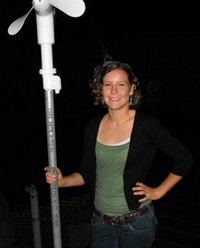 Over the summer I worked on the fabrication process of organic photovoltaics. Organic solar cells differ from other types of photovoltaics as they have the possibility to provide a cheap sustainable solution to current energy concerns. Organic photovoltaics (OPVs) can be processed using several methods. I focused on the efficacy of the spray coating process. Using an atomizer, bulk-heterojunction cells were fabricated by spraying a P3HT-TiO2 solution onto a substrate. To examine the cells, x-ray diffraction, UV/Vis photospectrometry, scanning electron microscopy, and a J-V analysis were done. The efficiencies of the cells and findings from these tests will be reported. The spray coating method has the opportunity to allow for the mass production of mobile thin film solar cells which can be integrated into construction, automobiles, furniture etc. Over the summer I worked on the fabrication process of organic photovoltaics. Organic solar cells differ from other types of photovoltaics as they have the possibility to provide a cheap sustainable solution to current energy concerns. Organic photovoltaics (OPVs) can be processed using several methods. I focused on the efficacy of the spray coating process. Using an atomizer, bulk-heterojunction cells were fabricated by spraying a P3HT-TiO2 solution onto a substrate. To examine the cells, x-ray diffraction, UV/Vis photospectrometry, scanning electron microscopy, and a J-V analysis were done. The efficiencies of the cells and findings from these tests will be reported. The spray coating method has the opportunity to allow for the mass production of mobile thin film solar cells which can be integrated into construction, automobiles, furniture etc.
Working with the IGERT SURE program was absolutely awesome as I got an intro into renewable energy technologies along with a good perspective on grad school. I had a really enjoyable summer working with side by side with grad students and professors. Their passion for solar hydrogen was contagious! I was so happy to be able to have this experience for the summer and get paid for it.
Derek Falcone
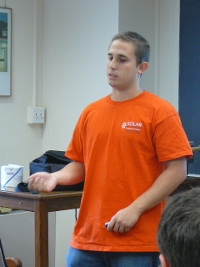 Over the summer I worked on optimizing a catalyst that decomposes ammonia into hydrogen and nitrogen. The goal of the overall project was to use this catalyst in a system which uses ammonia as a chemical carrier for hydrogen because ammonia can be more easily stored on board a car or another vehicle than hydrogen. My specific task was to optimize the calcination temperature of the catalyst. Microemulsion synthesis was used to create nano-sized catalytic particles of ruthenium. After mircoemulsion synthesis, it is desirable to burn off unwanted materials from the catalyst in order to increase the number of active sites. In order to find the optimal calcination temperature I used a thermalgravimetric analyzer (TGA) to study the mass of a sample as the temperature was altered. I also used CO chemisorption to further characterize my samples and a plug flow reactor to actually test my samples’ performances. Over the summer I worked on optimizing a catalyst that decomposes ammonia into hydrogen and nitrogen. The goal of the overall project was to use this catalyst in a system which uses ammonia as a chemical carrier for hydrogen because ammonia can be more easily stored on board a car or another vehicle than hydrogen. My specific task was to optimize the calcination temperature of the catalyst. Microemulsion synthesis was used to create nano-sized catalytic particles of ruthenium. After mircoemulsion synthesis, it is desirable to burn off unwanted materials from the catalyst in order to increase the number of active sites. In order to find the optimal calcination temperature I used a thermalgravimetric analyzer (TGA) to study the mass of a sample as the temperature was altered. I also used CO chemisorption to further characterize my samples and a plug flow reactor to actually test my samples’ performances.
Since I plan on attending graduate school after college, my IGERT SURE experience granted me a lot of insight to how the next couple years of my life will be. I was able to see what it is like to be a full time researcher and I was able to gain a lot of experience with different research techniques. However, the most useful aspect of my experience was communicating and interacting with several professors and graduate students who were always willing to teach me something about research and research life in general. I would recommend the IGERT SURE program to any student interested in graduate school or research in general; I guarantee you will learn a thing or two, and probably a whole lot more!
Melissa Forand
 This summer my assignment was to investigate the efficiency of the membranes in a PEM fuel cell. I compared the conductivity of the well known Nafion112 to a composite membrane, Nafion + SiO2. I tested the proton conductivity of the membranes at various climates, -30 -80°C. Also, I tested the conductivity after 200 freeze-thaw cycles. Assesment of membrane conductivity was performed using a four electrode conductivity cell using AC impedance. In addition, I was supposed to test the mechanical strength of the membranes after 200 freeze-thaw cycles, however, this was not acheived because most of my time was spent working with UD students and staff to stop the equipment from sensing external noise which was affecting the conductivity measurements. This summer my assignment was to investigate the efficiency of the membranes in a PEM fuel cell. I compared the conductivity of the well known Nafion112 to a composite membrane, Nafion + SiO2. I tested the proton conductivity of the membranes at various climates, -30 -80°C. Also, I tested the conductivity after 200 freeze-thaw cycles. Assesment of membrane conductivity was performed using a four electrode conductivity cell using AC impedance. In addition, I was supposed to test the mechanical strength of the membranes after 200 freeze-thaw cycles, however, this was not acheived because most of my time was spent working with UD students and staff to stop the equipment from sensing external noise which was affecting the conductivity measurements.
Overall my summer was interesting and fun. I learned you have to have the initiative and the presence of mind to seek extra help. I would have gotten absolutely nowhere if I didn't ask people for help. I also leaned additional skills along the way including fixing equipment and soldering. I enjoyed research over the summer with the IGERT SURE because I could spend 8-10 hours a day, doing just my project and then I was able to spend the rest of my day however I felt like it. There was always something to do from Ultimate Frisbee, movie nights, tie dying, and bicycling. Furthermore, I was able to grasp better insight to what I would like to do after attaining my BS in Mechanical Engineering. Now, I know that pursuing a Masters or PhD is something I would definitely want to acheive.
Parag Jalan
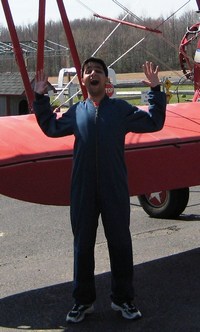 Because of issues associated with hydrogen storage, materials with a high H2 density have been proposed for use in mobile fuel cell applications. My research project was to develop an economically viable method of deriving CO-free H2 while avoiding the issues associated with H2 storage. The catalytic decomposition of ammonia is an attractive option since the only products are H2 and benign N2. However, current catalysts require high temperatures to attain a satisfactory conversion. This challenge necessitates exploration of novel catalytic materials that will be highly active at low temperatures for energy efficient ammonia decomposition. Furthermore, hydrogen from ammonia is obtained without the emission of harmful green house gases, thus being a prime compound for research. Because of issues associated with hydrogen storage, materials with a high H2 density have been proposed for use in mobile fuel cell applications. My research project was to develop an economically viable method of deriving CO-free H2 while avoiding the issues associated with H2 storage. The catalytic decomposition of ammonia is an attractive option since the only products are H2 and benign N2. However, current catalysts require high temperatures to attain a satisfactory conversion. This challenge necessitates exploration of novel catalytic materials that will be highly active at low temperatures for energy efficient ammonia decomposition. Furthermore, hydrogen from ammonia is obtained without the emission of harmful green house gases, thus being a prime compound for research.
As an IGERT SURE student, I was able to devote the entire time to the research project and follow a set path towards achieving the desired goals. Furthermore, the ten week program provided me with a better insight into life as a graduate student as well as the academic rigor of a graduate program. Networking with faculty from various different departments and interactions with a diverse student group has truly made this summer a one-of-a-kind experience.
Sarah Laufer
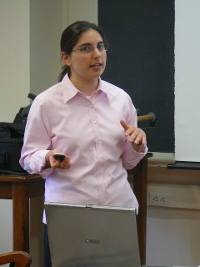 This summer I worked in the Fuel Cell Laboratory in the Department of Mechanical Engineering at the University of Delaware. The goal of my research was to relate the in-plane gas permeability to the saturation level of a carbon fiber-carbon composite gas diffusion layer. The experiment I inherited had a history of being fraught with challenges, and the majority of my summer was spent troubleshooting. What I learned the most from the experiment was how to deal with the daily realities of research – what to do when equipment malfunctions or results are illogical. This summer I worked in the Fuel Cell Laboratory in the Department of Mechanical Engineering at the University of Delaware. The goal of my research was to relate the in-plane gas permeability to the saturation level of a carbon fiber-carbon composite gas diffusion layer. The experiment I inherited had a history of being fraught with challenges, and the majority of my summer was spent troubleshooting. What I learned the most from the experiment was how to deal with the daily realities of research – what to do when equipment malfunctions or results are illogical.
The goal of the experiment, however, was secondary to IGERT SURE’s goal (and my personal goal) of gaining real-world research experience and enhancing my knowledge of alternative energies - especially the photovoltaic and hydrogen fuel cell fields. Through a combination of site visits to research and manufacturing facilities, seminars that covered topics ranging from abstract writing to ethics, and presentations explaining the science driving new technologies, both those goals were achieved in ways that surpassed my expectations. Looking back on the 2.5 months spent on the IGERT SURE program, I can say that though my experiment may have failed to produce useful results, my summer was a definite success.
Ellen Reifler
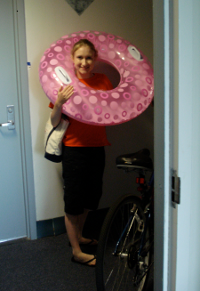 This summer I worked with Bill Shafarman at the Institute of Energy Conversion (IEC) at the University of Delaware. With Dr. Shafarman’s help, I tested Cu(InGa)Se2 (CIGS) thin film solar cells with different bandgaps to determine the cell’s responses at different temperatures. In an environmental chamber, we measured the open-circuit voltage, short-circuit current density, fill factor, and efficiency of three cells at temperatures between -50ºC and 100ºC. We were especially interested in the data taken when the cell was at temperatures higher than room temperature because when a solar cell is used commercially on a rooftop it will need to operate at temperatures higher than room temperature. From the measured data, we were able to determine that while a CIGS cell’s efficiency will decrease as temperature increases, widening the bandgap of the cell will lessen this decrease. This summer I worked with Bill Shafarman at the Institute of Energy Conversion (IEC) at the University of Delaware. With Dr. Shafarman’s help, I tested Cu(InGa)Se2 (CIGS) thin film solar cells with different bandgaps to determine the cell’s responses at different temperatures. In an environmental chamber, we measured the open-circuit voltage, short-circuit current density, fill factor, and efficiency of three cells at temperatures between -50ºC and 100ºC. We were especially interested in the data taken when the cell was at temperatures higher than room temperature because when a solar cell is used commercially on a rooftop it will need to operate at temperatures higher than room temperature. From the measured data, we were able to determine that while a CIGS cell’s efficiency will decrease as temperature increases, widening the bandgap of the cell will lessen this decrease.
Overall, the IGERT SURE was a rewarding and very enjoyable experience. My supervisor, as well as everyone else working at IEC, was always incredibly helpful and nice. This summer opened my eyes to opportunities for after college- I got a taste of what it’s like to do research, I was able to talk to graduate students about the graduate school experience, and we visited GE, DuPont, Air Liquide, and Exxon-Mobile. Best of all- I learned a lot this summer about my specific project, and I got to learn about other alternative energy research!
Brian Reindl
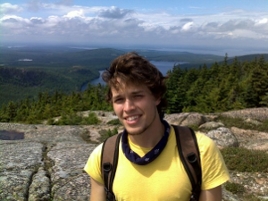 This Summer I worked in the Materials Science and Engineering (MSE) department under Professor Robert Opila with the help of graduate
students Conan Weiland and Bakhtyar Ali. I was studying the interface
between poly(3-hexylthiophene) (P3HT) and aluminum in
bulk-heterojunction (BHJ) organic solar cells based on P3HT:PCBM as
the active layer. The primary tool I used to study this interface was
X-Ray Photoelectron Spectroscopy (XPS), but with help from Conan and
Bakhtyar I was also able to augment this data with Atomic Force
Microscopy (AFM) and Scanning Electron Microscopy (SEM).
Throughout the course of the SURE program I was able to greatly
increase my knowledge of research equipment as well as my data
analysis skills, however perhaps the most valuable aspect of this
program to me was its interdisciplinary focus. Speaking with IGERT
students from diverse backgrounds and participating in the IGERT
conference at the end of the summer greatly broadened my understanding
of the multi-dimensional approach that must be taken to face our
current world energy crisis. This Summer I worked in the Materials Science and Engineering (MSE) department under Professor Robert Opila with the help of graduate
students Conan Weiland and Bakhtyar Ali. I was studying the interface
between poly(3-hexylthiophene) (P3HT) and aluminum in
bulk-heterojunction (BHJ) organic solar cells based on P3HT:PCBM as
the active layer. The primary tool I used to study this interface was
X-Ray Photoelectron Spectroscopy (XPS), but with help from Conan and
Bakhtyar I was also able to augment this data with Atomic Force
Microscopy (AFM) and Scanning Electron Microscopy (SEM).
Throughout the course of the SURE program I was able to greatly
increase my knowledge of research equipment as well as my data
analysis skills, however perhaps the most valuable aspect of this
program to me was its interdisciplinary focus. Speaking with IGERT
students from diverse backgrounds and participating in the IGERT
conference at the end of the summer greatly broadened my understanding
of the multi-dimensional approach that must be taken to face our
current world energy crisis.
Further Information
Please read about how to apply for our SURE on the following link : Apply for SURE
Looking forward to hearing from soon…
|
